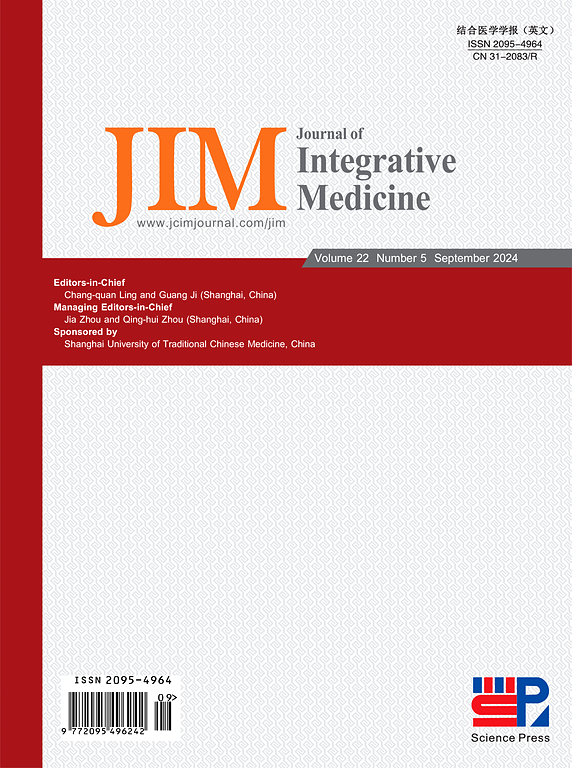Hongjin Xiaojie Capsule, a Chinese patent medicine, for treating moderate to severe cyclical breast pain: A single-blind randomized controlled trial
IF 4
2区 医学
Q1 INTEGRATIVE & COMPLEMENTARY MEDICINE
引用次数: 0
Abstract
Background
Moderate to severe breast pain has major effects on the quality of life for patients. Patent Chinese medicines are widely used in the treatment of breast pain due to their stable dosage form and good efficacy.
Objective
To evaluate the beneficial effects and safety of Hongjin Xiaojie Capsule (HJXJC), a Chinese patent medicine, for the treatment of cyclical breast pain.
Design, setting, participants and intervention
This is a multicenter, single-blind randomized controlled trial conducted in 3 medical centers in China from 2019 to 2021. Patients with moderate to severe cyclic breast pain were randomly divided into the intervention group (who took HJXJC, four capsules per dose, three times a day for 12 weeks) and the control group (waiting for the treatment) in a 1:1 ratio.
Main outcome measures
The primary outcome was pain duration, and the patients recorded measurements at baseline and at the end of weeks 4, 8, 12 and 16 on a patient log card.
Results
The full analysis set (FAS) population included 298 participants (intervention group, n = 150; control group, n = 148), while the per-protocol analysis set (PPS) included 274 participants. After 12 weeks, the duration of breast pain was significantly shorter in the intervention group (FAS: mean difference, –6.69; 95% CI, –7.58 to –5.80; P < 0.01, vs control. PPS: mean difference, –7.09; 95% CI, –8.01 to –6.16; P < 0.01, vs control). The Short-form McGill Pain Questionnaire (SF-MPQ) scores were significantly lower in the intervention group (FAS: mean difference, –12.55; 95% CI, –13.90 to –11.21; P < 0.01, vs control. PPS: mean difference, –13.07; 95% CI, –14.48 to –11.66; P < 0.01, vs control). The above indicators continued to be significantly different through week 16. Moreover, in the intervention group, breast lumps shrank after 12 weeks and the size of breast lumps was statistically smaller than that in the control group (P < 0.05), whereas the sizes of breast nodules and uterine fibroid showed no statistically significant difference compared with the control group (P > 0.05). At weeks 8 and 12, the dysmenorrhea scores in the intervention group were lower than those in the control group (P < 0.05). No obvious adverse reactions were observed in any group.
Conclusion
HJXJC can significantly shorten the duration of breast pain, reduce breast pain, reduce the size of breast lumps, and relieve dysmenorrhea. However, it has no significant effect on the size of breast nodules or uterine fibroid.
Trial registration
This trial has been registered at the ISRCTN Registry. Number: ISRCTN44184398.
Please cite this article as
Zhang Q, Fan YY, Wu XQ, Huo YD, Wang CH, Liang SB, Wang T, Zhong R, Wang X, Lai BY, Pei XH, Liu JP. Hongjin Xiaojie Capsule, a Chinese patent medicine, for treating moderate to severe cyclical breast pain: A single-blind randomized controlled trial. J Integr Med. 2024; 22(5): 552–560.
中成药红金消结胶囊治疗中重度周期性乳房疼痛:单盲随机对照试验。
背景:中重度乳房疼痛对患者的生活质量有很大影响。中成药因其剂型稳定、疗效好而被广泛用于乳房疼痛的治疗:评估中成药红金消结胶囊(HJXJC)治疗周期性乳房疼痛的有效性和安全性:这是一项多中心、单盲随机对照试验,于2019年至2021年在中国的3个医疗中心进行。按1:1的比例将中重度周期性乳房疼痛患者随机分为干预组(服用海正羟江胶囊,每次4粒,每天3次,共12周)和对照组(等待治疗):主要结果是疼痛持续时间,患者在基线和第 4、8、12 和 16 周结束时在患者记录卡上记录测量结果:完整分析集(FAS)包括 298 名参与者(干预组,n = 150;对照组,n = 148),而按方案分析集(PPS)包括 274 名参与者。12 周后,干预组的乳房疼痛持续时间明显缩短(FAS:平均差异,-6.69;95% CI,-7.58 至 -5.80;P 0.05)。在第 8 周和第 12 周,干预组的痛经评分低于对照组(P 结论:干预组的痛经评分低于对照组:HJXJC能明显缩短乳房疼痛的持续时间,减轻乳房疼痛,缩小乳房肿块,缓解痛经。但对乳房结节或子宫肌瘤的大小无明显影响:本试验已在 ISRCTN 注册中心注册。本文引用如前:Zhang Q, Fan YY, Wu XQ, Huo YD, Wang CH, Liang SB, Wang T, Zhong R, Wang X, Lai BY, Pei XH, Liu JP.中成药红金消结胶囊治疗中重度周期性乳房疼痛:单盲随机对照试验。J Integr Med.2024; Epub ahead of print.
本文章由计算机程序翻译,如有差异,请以英文原文为准。
求助全文
约1分钟内获得全文
求助全文
来源期刊

Journal of Integrative Medicine-Jim
Medicine-Complementary and Alternative Medicine
CiteScore
9.20
自引率
4.20%
发文量
3319
期刊介绍:
The predecessor of JIM is the Journal of Chinese Integrative Medicine (Zhong Xi Yi Jie He Xue Bao). With this new, English-language publication, we are committed to make JIM an international platform for publishing high-quality papers on complementary and alternative medicine (CAM) and an open forum in which the different professions and international scholarly communities can exchange views, share research and their clinical experience, discuss CAM education, and confer about issues and problems in our various disciplines and in CAM as a whole in order to promote integrative medicine.
JIM is indexed/abstracted in: MEDLINE/PubMed, ScienceDirect, Emerging Sources Citation Index (ESCI), Scopus, Embase, Chemical Abstracts (CA), CAB Abstracts, EBSCO, WPRIM, JST China, Chinese Science Citation Database (CSCD), and China National Knowledge Infrastructure (CNKI).
JIM Editorial Office uses ThomsonReuters ScholarOne Manuscripts as submitting and review system (submission link: http://mc03.manuscriptcentral.com/jcim-en).
JIM is published bimonthly. Manuscripts submitted to JIM should be written in English. Article types include but are not limited to randomized controlled and pragmatic trials, translational and patient-centered effectiveness outcome studies, case series and reports, clinical trial protocols, preclinical and basic science studies, systematic reviews and meta-analyses, papers on methodology and CAM history or education, conference proceedings, editorials, commentaries, short communications, book reviews, and letters to the editor.
Our purpose is to publish a prestigious international journal for studies in integrative medicine. To achieve this aim, we seek to publish high-quality papers on any aspects of integrative medicine, such as acupuncture and traditional Chinese medicine, Ayurveda medicine, herbal medicine, homeopathy, nutrition, chiropractic, mind-body medicine, taichi, qigong, meditation, and any other modalities of CAM; our commitment to international scope ensures that research and progress from all regions of the world are widely covered. These ensure that articles published in JIM have the maximum exposure to the international scholarly community.
JIM can help its authors let their papers reach the widest possible range of readers, and let all those who share an interest in their research field be concerned with their study.
 求助内容:
求助内容: 应助结果提醒方式:
应助结果提醒方式:


